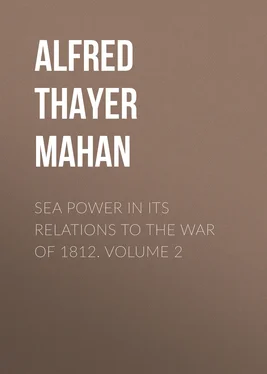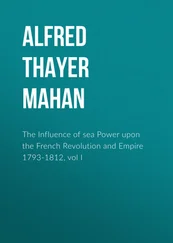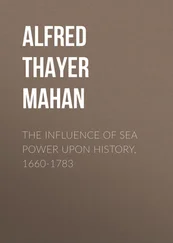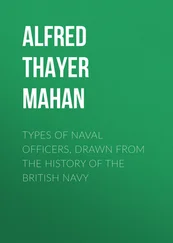Alfred Thayer Mahan - Sea Power in its Relations to the War of 1812. Volume 2
Здесь есть возможность читать онлайн «Alfred Thayer Mahan - Sea Power in its Relations to the War of 1812. Volume 2» — ознакомительный отрывок электронной книги совершенно бесплатно, а после прочтения отрывка купить полную версию. В некоторых случаях можно слушать аудио, скачать через торрент в формате fb2 и присутствует краткое содержание. Жанр: foreign_prose, История, foreign_edu, foreign_antique, на английском языке. Описание произведения, (предисловие) а так же отзывы посетителей доступны на портале библиотеки ЛибКат.
- Название:Sea Power in its Relations to the War of 1812. Volume 2
- Автор:
- Жанр:
- Год:неизвестен
- ISBN:нет данных
- Рейтинг книги:5 / 5. Голосов: 1
-
Избранное:Добавить в избранное
- Отзывы:
-
Ваша оценка:
- 100
- 1
- 2
- 3
- 4
- 5
Sea Power in its Relations to the War of 1812. Volume 2: краткое содержание, описание и аннотация
Предлагаем к чтению аннотацию, описание, краткое содержание или предисловие (зависит от того, что написал сам автор книги «Sea Power in its Relations to the War of 1812. Volume 2»). Если вы не нашли необходимую информацию о книге — напишите в комментариях, мы постараемся отыскать её.
Sea Power in its Relations to the War of 1812. Volume 2 — читать онлайн ознакомительный отрывок
Ниже представлен текст книги, разбитый по страницам. Система сохранения места последней прочитанной страницы, позволяет с удобством читать онлайн бесплатно книгу «Sea Power in its Relations to the War of 1812. Volume 2», без необходимости каждый раз заново искать на чём Вы остановились. Поставьте закладку, и сможете в любой момент перейти на страницу, на которой закончили чтение.
Интервал:
Закладка:
Quitting now the discussion of proprieties, the order of events seems to have been as follows: Perry having taken the initiative of bearing down, under increased sail, Elliott remained behind, governed by, or availing himself of—two very different motives, not lightly to be determined, or assumed, by the historian—the technical point, long before abandoned in practice, that he could not leave his place in the line without a signal. Thus his action was controlled by the position of his next ahead in the line, the dull-sailing "Caledonia," a vessel differing radically from his own in armament, having two long and for that day heavy guns, quite equal in range and efficiency to the best of the "Detroit's," 93 93 The "Caledonia" had two long 24-pounders, and one other lighter gun, variously stated. The "Detroit's" heaviest were also two long 24's; she had besides one long 18, six long 12's, etc.
and therefore capable of good service, though possibly not of their best, from the distance at which Perry changed his speed. Elliott's battery was the same as Perry's. He thus continued until it became evident that, the "Queen Charlotte" having gone to the support of the "Detroit," the "Lawrence" was heavily overpowered. Then, not earlier than an hour after Perry bore down, he realized that his commander-in-chief would be destroyed under his eyes, unless he went to his support, and he himself would rest under the imputation of an inefficient spectator. He ordered the "Caledonia" to bear up, in order that he might pass (position 3; C 1, C 2). Though not demonstrably certain, it seems probable that the wind, light throughout, was now so fallen as to impede the retrieval of his position; the opportunity to close, used by Perry, had passed away. At all events it was not till between 2 and 2.30 that the "Niagara" arrived on the scene, within effective range of the carronades which constituted nine tenths of her battery.
With this began the second stage of the battle (3). Perry's bearing down, receiving only the support of the long guns of the "Caledonia" and of the schooners ahead of him, had brought the "Lawrence" into hot engagement with the "Detroit," supported a half hour later by the "Queen Charlotte." By a little after two o'clock both flagships were well-nigh disabled, hull and battery; the "Lawrence" most so, having but one gun left out of ten on the broadside. "At 2.30," wrote Barclay, "the Detroit was a perfect wreck, principally from the raking fire of the gunboats." Which gunboats? Evidently the "Ariel" and "Scorpion," for all agree that the rear four were at this hour still far astern, though not absolutely out of range. To these last was probably due the crippling of the "Lady Prevost," which by now had gone to leeward with her rudder injured. Up to this time, when the first scene closed, what had been the general course of the action? and what now the situation? Assuming, as is very probable, that Barclay did not open with his long 24's until Perry was a mile, two thousand yards, from him,—that distance requiring six degrees elevation for those guns,—an estimate of speeds and courses, as indicated by the evidence, would put the "Lawrence" in action, at two hundred and fifty yards, at 12.10. This calculation, made independently, received subsequent confirmation in consulting Barclay's report, which says 12.15. 94 94 With reference to times, always very difficult to establish, and often very important as bases of calculation, the following extract from the Diary of Dr. Usher Parsons, surgeon of the "Lawrence," possesses value; the more so as it is believed to have been copied from the log of the vessel, which afterwards disappeared. The phraseology is that of a log and a seaman, not of a physician. "At 10 called all hands to quarters. A quarter before meridian the enemy began action at one mile distance. In a half hour came within musket-shot of the enemy's new ship.... At 1.30, so entirely disabled we could work the brig no longer. At 2 P.M., most of the guns were dismounted, breechings gone, or carriages knocked to pieces. At half-past two, when not another gun could be worked or fired, Captain Perry hauled down the fighting flag [not the national flag], which bore this motto 'Don't give up the ship,' and repaired on board the 'Niagara,' where he raised it again. In ten minutes after we struck." Publications of the Rhode Island Historical Society, vol. vii. p. 244. This was called to the author's attention after the account in the text was written.
The same time, for the duller "Caledonia" and the "Niagara," would place them one thousand yards from the British line. This range, for the 32-pounder carronades of the "Niagara," and the 24's of the "Queen Charlotte," required an elevation of from four to six degrees. Coupling this with the British statement, that the carronades of the "Charlotte" could not reach the "Niagara," we obtain probable positions, two hundred and fifty yards and one thousand yards, for the principal two American vessels at quarter-past noon.
From the general lightness and occasional failure of the wind up to 2 P.M., it is more than likely that no great change took place before that hour. What air there was might touch all alike, but would affect least the "Lawrence," "Detroit," and "Queen Charlotte," because their sails were being rent; and also they were in the centre of the cannonade, which is believed usually to kill the breeze. The tendency of the "Caledonia," "Niagara," and American vessels in rear of them, between 12.30 and 2 P.M., during which period, to use Barclay's report, "the action continued with great fury," would therefore be to approach slowly the scene where the "Lawrence," supported by the long guns of the "Ariel," "Scorpion," and "Caledonia," maintained the day against the "Detroit" and "Queen Charlotte," backed by the schooner "Chippewa" and the 6 and 4 pounder pop-guns of the "Hunter." How near they drew is a mere matter of estimate. Taking all together, it may be inferred that the "Niagara" had then been carried as close as five hundred to six hundred yards to the British line, but it would appear also towards its rear; rather, probably, that the British had advanced relatively to her, owing to her course being oblique to theirs.
The situation then was as follows: The "Lawrence," disabled, was dropping astern of the "Detroit," "Queen Charlotte," and "Hunter." More than half her ship's company lay dead or wounded on her decks. Her loss, 83 killed and wounded out of a total of 142,—sick included, 95 95 Mackenzie's Life of Perry, vol. ii. p. 283.
—was mostly incurred before this. With only one gun left, she was a beaten ship, although her colors were up. The "Detroit" lay in the British line almost equally mauled. On her lee quarter,—that is, behind, but on the lee side,—and close to her, was the "Queen Charlotte." Her captain, second to Barclay, had been killed,—the first man hit on board,—and her first lieutenant knocked senseless; being succeeded in command by an officer whom Barclay described as of little experience. The first lieutenant of the "Detroit" was also wounded mortally; and Barclay himself, who already had been once hit in the thigh, was now a second time so severely injured,—being his eighth wound in battle, though now only thirty-two,—that he was forced at this critical instant to go below, leaving the deck with the second lieutenant. The "Hunter" was astern of her two consorts. The "Lady Prevost," fifth in the British order, had fallen to leeward with her rudder crippled. The position of the leading and rear British schooners is not mentioned, and is not important; the reliance of each being one long 9-pounder gun.
Before this, taking advantage of the breeze freshening, the "Niagara" had gone clear of the "Caledonia," on her windward side, and had stood to the southwest, towards the "Detroit." She had not at first either foresail or topgallantsails set; and since she passed the "Lawrence" to windward, she was then almost certainly over two hundred and fifty yards from the British line, for there is no conclusive proof that the "Lawrence" was nearer than that. Combining the narrative of the British commodore with that of his second lieutenant, who now took charge, it appears that Barclay, before going below, saw a boat passing from the "Lawrence" to the "Niagara," and that the second lieutenant, Inglis, after relieving him, found the "Niagara" on the weather beam of the "Detroit." Perry, seeing the "Lawrence" incapable of further offensive action, had decided to leave her and go on board the "Niagara," and in this brief interval was making his passage from one vessel to the other. After leaving the "Lawrence" astern, the "Niagara" had made sail; the foresail having been set, and the topgallantsails "in the act of being set, before Captain Perry came on board." 96 96 Evidence of Midshipman Montgomery of the "Niagara," before the Court of Inquiry.
This necessarily prolonged the time of his passage, and may have given rise to the opprobrious British report that she was making off. Her making sail as she did indicated that she had suffered little aloft; she had been out of carronade range, while her consort, still in fighting condition, was bearing the brunt; it was natural to conclude that she would not alone renew the action, now that the "Lawrence" was hopelessly disabled. The wish, too, may possibly have helped the thought. The "Lawrence," in fact, having kept her colors flying till Perry reached the "Niagara," struck immediately afterwards. Had she surrendered while he was on board, he could not honorably have quitted her; and the record was clearer by his reaching a fresh ship while the flag of the one he left was still up.
Интервал:
Закладка:
Похожие книги на «Sea Power in its Relations to the War of 1812. Volume 2»
Представляем Вашему вниманию похожие книги на «Sea Power in its Relations to the War of 1812. Volume 2» списком для выбора. Мы отобрали схожую по названию и смыслу литературу в надежде предоставить читателям больше вариантов отыскать новые, интересные, ещё непрочитанные произведения.
Обсуждение, отзывы о книге «Sea Power in its Relations to the War of 1812. Volume 2» и просто собственные мнения читателей. Оставьте ваши комментарии, напишите, что Вы думаете о произведении, его смысле или главных героях. Укажите что конкретно понравилось, а что нет, и почему Вы так считаете.












